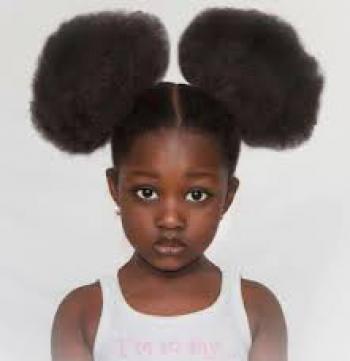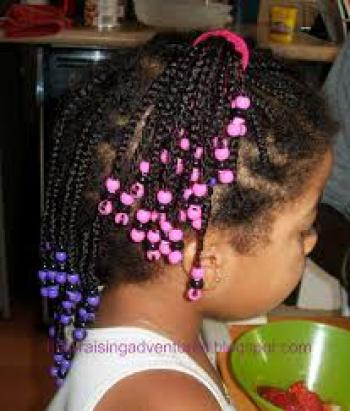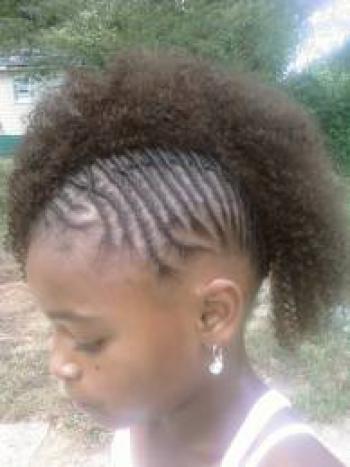Serendip is an independent site partnering with faculty at multiple colleges and universities around the world. Happy exploring!
Web Event 2

Hair Politics: Afros, Braids and Locks in schools
“Trying to make hair beautiful on the outside causes damage deep inside”, declares an ad for Dove hair moisturizer. And indeed trying to straighten, curl, color and do a number of things with hair, especially women’s hair, can cause damage to the follicles. But this “damage deep inside” is more than just physical damage to the hair itself. The cost of beauty in America for young girls, and most specifically Black girls, is destructive. The Europeanized standard of beauty that dominates American culture is one that most Black women naturally cannot match up with, but the pressure to do so is tremendous. From TV ads, to billboards, actresses in movies, Barbie’s, and models, long, straight, silky hair has been a celebrated characteristic. So to match up with these “ideal images” many Black girls and women alike go through processes to straighten and lengthen their hair. But many of these processes involve chemicals and heat that damage the hair. Even more damaging though, is the lowered self-esteem of those who cannot attain what the popular media deems as “beauty”.
However, not all Black girls and women feel the need, desire, or have the patience to transform their hair to a straighter state. Many Black women wear and embrace their hair natural and allow the same for their daughters; natural meaning that the hair is left the way it has grown out of the head. Many women also wear any of the multifarious styles of braids, twists, cuts, and locks (also known as dreadlocks) or change it up constantly between the many. The endless variety of hair styles, whether worn natural, a wig, or straightened, exemplifies the uniqueness and creativity within the Black community. This diversity of hair is not a common aspect among too many other races and the reception of these many styles, especially in public schools are not conventional.
Primary and secondary institutions of learning are said to be one of the first forms of organized socialization, where “cultural norms, values, and skills necessary to survive in society” are learned (Lorber). It is through these institutions in which students learn what is “acceptable” and “descent” and what is not. And for one elementary school in Tulsa, OK, it was taught that having locks was not acceptable.
Tiana Parker, a 7 year old second grader sporting cute, wiry chin length locks, was asked to change her hairstyle because they could “distract from the respectful and serious atmosphere [the school] strives for” claimed the Deborah Brown Community School that Parker attended (Huffingtonpost). According to the school dress code “afros, dreadlocks, mohawks and other faddish styles” were not allowed. Parker’s parents were asked to change their daughter’s hairstyle, but they refused to do so and instead decided to dis-enroll their child from the school. This incident received nationwide coverage and many, including MSNBC host Melissa Harris-Perry, took up a stance against the school policy. For many it is shocking that in this day and age racially charged discrimination continues, although in a newer more subtle form. Eventually,the school apologized and revoked the policy.
Tiana’s story, although recieveing much attention, is not uncommon; many schools have dress code policies that ban afros, locks and mohawks, and there have been several cases in which students are asked to change their hairstyle, and in more severe instances students have been expelled for wearing these do’s. The “well-intentioned” school policy that the institution believes is viable is actually most astounding. Afro’s are the most natural form in which many Black people's hair grows. And braids and locks are practical and culturally defining forms of styling and wearing their hair, therefore for many Black Americans, like actress Tracie Thomas it seems “amazing that it is considered revolutionary to wear [her] hair the way it grows out of [her] head”. Whereas, if a Black student were to have their hair relaxed, or permed or wear a wig, mirroring the white Eurocentric standard, it would be acceptable and even favored. Through this incident and school policies such as these the ideas of normative culture are formed, and according to this “norm”, natural Black hair does not fit in.
As a Black women myself, growing up in predominantly white neighborhoods and school systems, the micro-aggressive comments and questions I received, and many other Black girls often receive about their hair from peers and teachers, are indicative of the abnormality of Black hair. The “can I touch it?” phenomenon is probably one of the most well-known among Black girls. The thick, curly, defined texture of natural Black hair has attracted many curious prodding fingers to touch what seems to be the fascinating mystery of such hair, and so “can I touch it?” becomes one of the questions Black women sporting natural hair receive from whites and other races with typically finely textured hair. Other styles besides natural are also cause for curious attraction such as the many styles of braiding and locking, the assortment of beads, shells, and barrettes that can decorate the hair and the extensions that can be braided into the hair. The attention this hair receives from non-Black communities, that fascinates and appropriates, but does not affirm perpetuates the “otherness” of Black hair.
The exclusion of the hair of Black boys is not to say that they too do not face the same stigma and threat of being seen as unfitting in society, but to instead highlight the increased pressure on young Black women in a society where female beauty is highly valued and hair being a dominant form of beauty is excessively emphasized. The rates of low self-esteem are exponentially higher in girls and young women compared to boys and men because of the projected ideals of beauty, which are often unattainable, and superficial. For Black girls the societal implication of Black as inferior, females as inferior, and natural Black hair and hairstyles as unacceptable, can tint their perception of the reality of their beauty.
School, especially middle and high school, are already difficult places to face in the midst of forming self-identity and searching for the answer of the age old question, who am I? But in an institution that devalues the essential qualities of who you are, finding oneself, and appreciating oneself can be even more of a notion. School institutions that ban afros and locks are ostracizing the culture and nature of Black student’s identity, furthering the racist ideology that most Americans think we have bypassed. But afros, locks, cornrolls, microbraids, twists, crocheted dreads, braids with beads, bob cuts, relaxed hair, permed hair, wigs, short cuts, long hair, red hair, black hair, orange hair and purple hair all are encompassed in prominent Black hairstyles and deserve to be seen for their individuality, uniqueness, creativity and beauty.
The racist underlying’s of school principle does not stand alone as the sole factor contributing toward the othering of Black culture, and particularly Black hair. However, because primary and secondary education are the foundation of individual development, adapting these institutions to better accommodate for Black hair is a good start. One way in which the affirmation of Black hair can be instituted is through the abolishment of such school legislation that prohibits “faddish” styles that are intrinsic to Black culture. To ban afros would be like banning blonde hair, in order to do so a natural blonde would have to change the way their hair is naturally. Another step that can be taken is through education. Incorporating the celebration of Black individuals and other people of color into textbooks and curriculum would expose non-Blacks to the diversity of Black culture, looks and representation. It would also foster higher self-esteem and encouragement for Blacks and other students of color to see individuals that look like them and have similar experiences as them, in positions of power and credentialed. And the small section on “Black history” in most text books will not suffice.
One crucial development that could change the unequal and unjust race dynamic in diverse classrooms would be to create a safe place in which students could hold conversations about differences in culture such as hair. It would be necessary and important for teachers to be educated about the diverse nature of traditions, hairstyles, clothing, norms and customs of different races and ethnicities. And also, more importantly teachers would need to understand the persitent forms in which institutionalized racism operates and the various intersectional identities that operate within schools in order to help guide and manage these class discussions.
Despite all the ways in which society often devalues the varieties of Black hair, there have been and still are many mediums and outlets that have been created to appreciate Black hair. For example, famous R&B singer India Arie has a song called “I am not my hair”, which is a powerful affirmation of self-definition based not on one’s hair and physical features. The song states, “I am not my hair, I am not this skin, I am not your expectations no, I am not my hair, I am not this skin, I am a soul that lives within”. This affirmative ballad pushes back on the notion that a Black girl or woman's identity can be determined from how she wears her hair Also, Chris Rock’s film “Good Hair” takes a look into what is deemed as “good hair” in the United States and delves into the Black hair industry and culture. He illustrates to his audience that the Black community spends several hundreds of dollars on lond straight hair, usually sent from India as a way to enhance their look. However, Rock demonstrates that if someone were to try to sale an Afro wig, they would have very little luck in hopes of opening the eyes of those entrenched in shame towards their own hair.
More interestingly, artist Endia Beal has created a series of portraits entitled “Corporate Portraits of White Women with Black Hairstyles” to illustrate how it might look if black hairstyles were not considered “political statements” or “radical”, but rather the norm.In the photos she has designed white women in business attire pose with typical Black hair styles. The photos are comical and feel starkly out of place, furthering the concept of common Black hair styles as unprofessional and not to be taken seriously.
Women should not have to feel pressured to “make their hair beautiful”, it should be considered beautiful naturally, which it is. Whether a hair style is chosen out of want for attraction, practicality, self-content, a political statement, or just cause, it is neither a sign of deviance, a site of distraction, or abnormal. It is time to disassociate “kinky”, “dreadful dreads”, “nappy”, “ugly”, and “unacceptable” with Black hair, and instead embrace the versatility and diversity of Black hair and the personalities that wear them. One of the first steps towards justice can be through the transformation of schools which are charged with socializing and educating the next generation of Americans who are the future of the country. “Trying to make hair beautiful on the outside causes damage deep inside”… unless it can be seen as beautiful naturally.
Bibliography
Klein, Rebecca. "Tiana Parker, 7, Switches Schools After Being Forbidden From Wearing Dreads." The Huffington Post. TheHuffingtonPost.com, 05 Sept. 2013. Web. 03 Nov. 2013.
Lorber, Judith, and Susan A. Farrell. "Night To His Day." The Social Construction of Gender. Newbury Park, CA: Sage Publications, 1991. 102. Print.
Tiana Parker

Banned Hairstyles






Comments
Black Hair is beautiful
I was very suprised at the things that happened to those young girls regarding their hair. I know I've faced discrimination throughout my life about my hair especially being that I am natural. This idea of how hair should look is quite offensive. Attending Bryn Mawr has made it even more appearant being that the majority of the student body is White. I've only been here for 3 months and I've already gotten the questions " Can I touch it?" Is that real? As frustrating as these questions are I am forced to accept it because those student "just dont understand." There needs to be more awareness about black hair but also more acceptance. Haverford College has a campign right now on facebook glorifying black hair. It's very interesting to read the responses people have said to combat the stigma. Heres the Link :https://www.facebook.com/events/267184743406286/269375679853859/?notif_t=plan_mall_activity
I cannot believe that any
I cannot believe that any institution would ban afros or locks! The metaphor of banning blond hair really made it clear to me how discriminatory school rules can be. Black women have brought such creativity and innovation to hair design, and it's frustrating to have both natural and made-up hair devalued. Why can't people have more open minds about creative self-expression?
In class when you said your
In class when you said your paper topic I immediately knew I wanted to read it! I am shocked at the way the schools you talked about treated Black students who wore their hair naturally. The whole "can I touch it" thing is definitely something I have done at school with friends, and you made me think of it in a whole new way. It is ridiculous that natural Black hairstyles have been so repressed that when we see them it is like an amazing, exciting experience. It also shows how white (and white hair specifically for this) is the unconscious norm, which as you said "perpetuates the “otherness” of Black hair."
Political Hair
So, ari, I was with you all the way,
… until the very end, when you surprised me with several switches. Your keynotes until that point had very clearly been about “appreciating Black hair”: you were exploring the self-esteem and self-empowerment of “naturalizing,” in contrast to the emotional and physical costs of “Europeanizing.” But then you introduced, in quick succession, India Arie’s song, powerfully affirming self-definition “NOT based not on hair and physical features”; Chris Rock’s “Good Hair,” which is quite explicit in making fun of the whole Black hair industry; and Endia Beal’s “corporate portraits,” which—far from featuring Black hair styles as comical and unprofessional—is an account of a Black women learning that “this idea of performativity crosses racial lines, gender lines and generational lines – people literally change themselves to fit in certain environments….It’s not just a minority thing. It’s a woman thing.”
What Beal seems to be discovering, in the process of creating her portraits, is what we were learning about in class September: the gap between who we think we are and how we perform in the world; the ways in which all of us are read, and mis-read, by others; the degree to which we can control the uptake. Beal’s portraits actually (and given this context, not so surprisingly) put me in mind of those that Laura Swanson did of several of us in this class, and her explanation (when I asked her to help me understand what she was up to) that they emerged from her “nomadic lifestyle”:
“I’ve had such profound experiences, but they are temporary. After they’re over, I go back to my everyday life of day jobs and other mundane stuff. So the experiences seem like a hallucination as they seem so distant….I wanted the portraits to reflect that. I wanted everyone to appear super-human, somewhere between a religious portrait , propaganda poster, and a modern editorial portrait you’d see in the New Yorker. I treated each portrait like a painting and applied contrasting layers of cold and warm light with super clarity/sharpness and softness. So the end result is something that is compelling, yet hard to place.”
To me, Beal’s portraits have a evoke a similar surreal feeling—discomfiting because hard to place, and a reminder that we are all performing, all the time, code-switching with our bodies as well as our language. How deep the “damage is on the inside” is painful –and very important-- to ask, but I’m not quite seeing how Beal’s art work, or Chris Rock’s, or India Arie’s, actually explore that question.
I’d also be curious to have you loop back now to your first web event, and think about how the College represents hair, as it represents us. In the official material used to advertise this place, are the portraits of us, in your terms, largely “Europeanized”?
No one else in the class wrote on your topic, but I’ve put together a somewhat “random” writing group: you, Polly and piper all wrote about different forms of intolerance, and I’m hoping might find some related areas to talk about…please read their papers and come to class ready to discuss!
I saw this powerful article
I saw this powerful article titled "White Women With Black Hairstyles Redefine Corporate America" on Huffington post a few weeks ago, and it really reminded me of your topic when you had mentioned it in class. I'm glad you included it in your paper because it definitely highlights the ridiculous stigma against various hairstyles.
http://www.huffingtonpost.com/2013/10/18/endia-beal_n_4116379.html